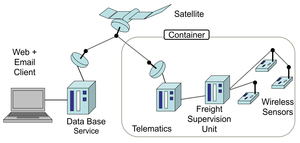The container as a communication and decision support tool
A so-called ‘Freight Supervision Unit’ (FSU) operates as the interface between the internal sensor network and external communication. Global communication is provided by a telematics unit. The container can be equipped with different units, either for the Iridium satellite network (OHB, Germany) or the GSM network (Cargobull Telematics, Germany).
The project title, ‘intelligent container’, indicates that the FSU is more than just a communication gateway. The basic function of the FSU is the provision of a software platform for a decision support tool (DST). Different freight-specific software bundles can be uploaded remotely, containing a shelf life model for the selected food product. The DST is able to detect ‘dangers’ for the specific products, and to trigger warning messages automatically. The software platform consists of the Jamaica Virtual Machine from AICAS, the OSGi framework from Prosyst, basic software bundles to control the container temperature set point, the sensor network and the communication system. The software packages from our partners were adapted to the target platform and extended to support the CAN bus for sensor interfaces.
We verified by measurements of required CPU time that even complex algorithms can be executed on the FSU and it is also possible to run shelf life models on sensor nodes and to install them remotely over a wireless network [![]() 1,2].
1,2].
The feasibility of remote access during trans-ocean and road transport was verified during several field tests. The data from the wireless sensor nodes were transferred once per day per satellite during a test transportation journey using bananas. The first estimation of remaining green life, cooling efficiency and respiration heat was calculated after 3 days. The estimation was continuously updated, and if a correction was necessary, the new values were sent over the satellite network, especially if a hazard for freight quality was detected.
A few hours before arrival at the harbour, access to the full recorded data was available, when the container was able to link to the GSM network. Temperature curves were displayed in a web browser. Remote monitoring continued during the subsequent ripening process. The temperature set point was adjusted several times to compensate for the higher respiration heat during ripening.
Relevant publications
- Dannies, A., Palafox-AlbarrŠn, J., Lang, W., Jedermann, R.: Smart dynamic software components enabling decision support in Machine-to-machine networks, International Journal of Computer Science Issues, January 2013, Vol. 10(1), pp. 540-550, ISSN (Print): 1694-0784 | ISSN (Online): 1694-0814 [
 Online] [
Online] [ PDF]
PDF] - Palafox-Albarran, J.; Dannies, A.; Sanjeeva, B. K.; Lang, W. and Jedermann, R.: Combining Machine-to-Machine Communications with Intelligent Objects in Logistics. In Proc. of ImViReLL'12 The Impact of Virtual, Remote and Real Logistics Labs, Springer 2012, pp. 102-112. [
 pdf]. DOI:
pdf]. DOI:  10.1007/978-3-642-28816-6_11
10.1007/978-3-642-28816-6_11
Contact
Reiner Jedermann, Institute for Microsensors-, actuators and -systems, University of Bremen, Germany, ![]() Email
Email
![]() Fridtjof Siebert, aicas realtime
Fridtjof Siebert, aicas realtime








